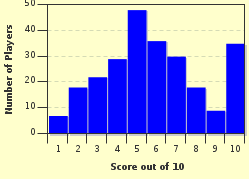Quiz Answer Key and Fun Facts
1. Although the Chinese have been growing and drinking tea for centuries, when asked, we seem to immediately declare this to be an exclusively English pastime. Despite causing a small fracas in Boston, and the indirect loss of a lot of pesky colonials, the English kept on drinking. How much tea was imported into England in 1784, when the population of England and Wales was approximately 8 million?
2. There was a great deal of money to be made in the growing and trading of tea. However, attempts to grow tea in India, a British colony, had failed for years. Transplanting species from other areas did not work. Eventually indigenous plants were discovered in the 1830s, which heralded the first Indian tea plantations. In what region of India was the first tea grown?
3. If one has the time and inclination to peruse the tea section of one's local grocery store, one will come across a variety of names and descriptions of Indian teas. Earl Grey, English Breakfast etc. are blends, to achieve uniformity, but what is Orange Pekoe?
4. By the Victorian era, meal habits of the upper classes were changing. Dinner was eaten later, which left a gaping hole in the day, and the stomach, at around 4 p.m. Who is supposed to have had the stroke of genius that created Afternoon Tea, and changed English life forever?
5. All of the answers below contributed to the many changes in English taste and habits regarding the consumption of tea, however one in particular had the biggest effect on the Indian Tea trade in general. What was this?
6. In the great history of tea consumption, we must give some mention of two innovations that were created somewhat fortuitously by those coffee-drinking ex-colonists of ours. One was iced tea, what was the other?
7. There is, of course, a correct way to make tea. If it's English tea, one would automatically assume there would be a correct way. No matter what the leaf, it is the way that the water is applied that makes all the difference. What is this magic tip?
8. Afternoon Tea is, in general, a fairly dainty affair, often with thin cucumber sandwiches, bereft of crusts. There may be a cake or biscuits, but nothing too substantial or fancy. Although the better London hotels do offer such extravagances that were never seen in my childhood.
In which Oscar Wilde play does the question of cucumber sandwiches arise?
9. There has generally been a little confusion, particularly across The Pond, as to the exact definition of High Tea, as opposed to Afternoon Tea. It IS one of the burning questions of the day. Let's see if you know.
10. Finally, I thought that I should mention the Cream Tea, and what exactly do we mean by clotted cream?
Source: Author
Englizzie
This quiz was reviewed by FunTrivia editor
Bruyere before going online.
Any errors found in FunTrivia content are routinely corrected through our feedback system.


